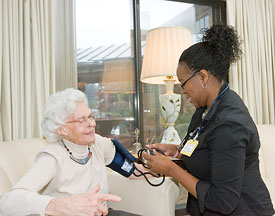In 1909 Michigan Visiting Nurses began as a service to treat the “needy sick” from the university hospital.
Many things have changed in the past 100 years, including technology and treatment protocols, but these nurses still carry a bag filled with wound care and other supplies into patients’ homes. MVN still provides home nursing care but now it also offers therapy and medical social work.

“Our visiting nurses play a vital role in health care today,” says Nancy Moran Rose, director, U-M Home Care Nursing and Operations. “They provide highly skilled care to patients in their homes. They are the eyes and ears for physicians, and they help manage acute and chronic illnesses with the help of technology to assist patients achieve independence with their care.”
How Michigan Visiting Nurses began
Around the beginning of the 20th century, the Hospital Circle of the Kings Daughters began to investigate how to help meet the medical needs of University Hospital patients and the Ann Arbor community.
They worked with U-M hospital leaders and physicians, the community and other Hospital Circle groups in the area. By 1909, they had obtained monetary pledges to support a salary for a full-time visiting nurse for the city of Ann Arbor.
“Although the high level of commitment to patient care has not changed in a hundred years, Michigan Visiting Nurses has been known by various names and undergone several major management changes,” says Toni Henkemeyer, program development manager, Michigan Visiting Nurses.
By the end of the 1920s, the Visiting Nurses Association became the Ann Arbor Public Health Nursing Association. The home care nurses merged with the Ann Arbor Health Department in 1948. Then in 1980, it became part of the Visiting Nurse Association of Huron Valley, which was acquired in 1998 by the U-M Health System Michigan Health Corporation.
The name change to Michigan Visiting Nurses occurred in 1999. In 2003 Michigan Visiting Nurses became employees of the U-M Health System, and in 2007 it became part of U-M Home Care Services, a department of U-M Hospitals and Health Centers.
What has changed most
General patient and family home care has remained fairly constant over the century. MVN now provides therapeutic nursing and therapy services supported by home health aides, nutritionists and medical social workers. They care for all patients from prenatal to the aged and provide specialized programs, such as psychiatric nursing, infusion, wound care, post-transplant care and other integrated programs with U-M hospitals.
|
The tools used by nurses in the home significantly have changed. In 1909 the nurses carried whiskey and glass catheters. Today they use IV antibiotics, computers, BlackBerry communication devices, digital cameras, pulse oximeters, glucometers and state-of-the-art wound care supplies.
Visiting nurses today also have access to patients’ U-M hospital and clinic records, so during a visit, a nurse can check on the most recent lab values, discharge summaries and latest medication changes. BlackBerry devices and laptop computers have enhanced the ability to communicate with other care providers, pharmacists and physicians.
Changes in care provided by visiting nurses
A typical day in 1927 for an Ann Arbor Public Health nurse would be to make about four to eight home visits plus a trip to an Ann Arbor public school, the Hoover Steel Ball Company or the Well Child Clinic.
In 2009 the nurse’s day typically begins with uploading patient information from the main computer system onto the laptop and confirming patient visits. Nurses make between four to eight visits per day, usually in one geographic area. They use their laptops to document visits and to communicate with other members of the health care team.
Today there are more than 200 field and office-based MVN staff working to provide and support patient care services. The main location is in Ann Arbor, with five other satellite offices across the seven-county service territory that covers Washtenaw, Livingston, Jackson, Oakland, Wayne, Monroe and Hillsdale.
According to Wendy Pratt, human resource manager, MVN, “We are hiring. We are always looking for quality nurses to be part of our team.”
For more information about Michigan Visiting Nurses and the wide range of services it offers, go to www.umvn.org.

